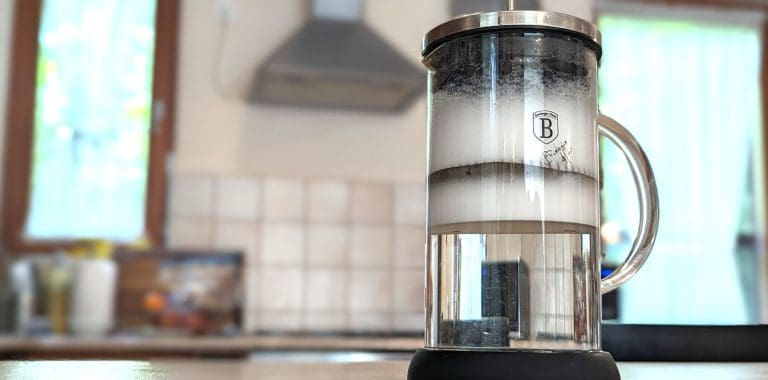Is the AeroPress Dishwasher Safe? 2 Better Ways to Clean It!
Are you wondering if your AeroPress coffee maker is safe to put in the dishwasher?
Look no further!
In this article, I will discuss whether an AeroPress is a dishwasher-safe appliance, and also provide tips on better ways to clean and maintain it so that you can enjoy a delicious cup of coffee with every brew.
So sit back, relax, and explore what lies ahead — from learning about the potential consequences of not regularly cleaning to discovering alternative methods like rinsing after each use or using vinegar solution for deep cleaning.
Let’s get started!
Is AeroPress Dishwasher Safe?
Cleaning is essential when the coffee maker gets dirty from spills and residue accumulation.
Yes, AeroPress is dishwasher-safe on the upper deck.

Meanwhile, the AeroPress Clear can be cleaned on both the top and bottom shelf, according to the AeroPress website.
However, I do not advise cleaning in a dishwasher after every use, because the silicone seal on the plunger can stiffen and deform from the excessively hot water used in a long dishwashing cycle.
Better Ways to Clean Your AeroPress
Here are 2 better ways to clean the Aeropress.
Rinse After Use

Rinsing is the best way to clean this versatile little coffee maker after each time you make a great cup of coffee with the Aeropress.
Here is the basic cleaning process, step by step:
- Screw off its filter cap.
- Dispose of the coffee puck.
- Pull out the plunger.
- Thoroughly rinse the cylinder, plunger, silicone seal, and filter holder with warm, soapy water. Doing so removes coffee oil and ensures that your next brew is perfect every time.
- DO NOT use any abrasive materials to clean any part of the Aeropress, as it could cause scratches.
If you want to go the extra mile, every few days, you can remove the seal from the plunger by holding the plunger and prying the seal off using your thumb. This makes the cleaning of the seal with mild dish soap possible.
This simple process should keep your AeroPress clean, after which you can let it dry naturally.
However, there is a risk of calcification from mineral residue in hard water. You could dab it dry instead, but I don’t. It will retain stains with time either way, hence the need for deep cleaning with vinegar.

Vinegar Solution for a Deep Clean
Deep cleaning requires a solution of white vinegar and water to remove tough stains in the coffee maker.
Here is how:
- The cleaning solution should be one part vinegar and three parts water, so it’s properly diluted.
- You will soak the AeroPress parts for 30 minutes or more after disassembling them. The soaking time will depend on how stained the AeroPress is.
- You will then rinse the device with warm water to wash the vinegar solution thoroughly.
Vinegar is the best for removing unwanted grime and coffee oil because it has a pH of 2.4, which is lower than that of coffee at around 5.0. This low pH level ensures that your device is clean and the coffee’s acidity won’t be different when you brew a cup.
In addition, vinegar breaks down the minerals in water to prevent calcification. Note that you can use dish soap, although it can risk leaving a chemical smell in your coffee.
The same procedures also apply to the other AeroPress variants, such as the AeroPress Go, AeroPress Clear, and AeroPress XL.
What Happens if You Don’t Clean Your AeroPress
I’m sure you wouldn’t leave dirty dishes lying around, right?

The same way, bad things start happening if you don’t clean up:
- For starters, coffee oil will accumulate in the cylinder and vacuum seal, making your brew appear greasy.
- These oils combine antioxidants and unsaturated fat, which aren’t dangerous but can ruin your coffee.
- Failure to clean will lead to a build-up of residual coffee grounds, which leads to stale coffee with a reduced aroma and flavor.
- In addition, the residue can go rancid to create an unpleasant bitter taste and smell.
Conclusion
Every coffee lover wants their brew in perfect condition, and a versatile brewer like AeroPress can give you that. However, this depends on factors like its cleanliness. You can use a dishwasher to clean it, although you risk premature replacement.
The best alternatives are rinsing after every use and soaking in a vinegar solution. Failure to do so leads to accumulating residual coffee grounds and oil, which can affect the quality of your brew.









Great read, Tom. However, I’m curious if you’ve experimented with any other cleaning agents that are effective, yet gentle on the AeroPress. Your approach with vinegar is solid, but I’m always on the lookout for alternatives, especially because vinegar has such a pungent odor that seems to linger. Any suggestions?
I usually just take the silicone bit off and put everything into the dishwasher every few weeks. My aeropress is spotless 🙂
Your article on AeroPress cleaning was enlightening, but now I’m intrigued. You mentioned the potential for the silicone seal to deform in the dishwasher. This is exactly what happened to mine. I had to replace the seal a few months ago, and now I only hand-wash it. I wish I’d come across this article earlier; it would have saved me a bit of trouble (and expense.).
Just wanted to express my deepest thanks for this fantastic article, Tom. I’ve been fretting over the discoloration inside my AeroPress, and your vinegar solution was a godsend. It’s like having a brand new appliance all over again – no more unsightly coffee stains. I can taste the difference in my morning brew too, but maybe that’s just me believing it is better. I wonder though, does the aciditiy of the vinegar damage the plastic?